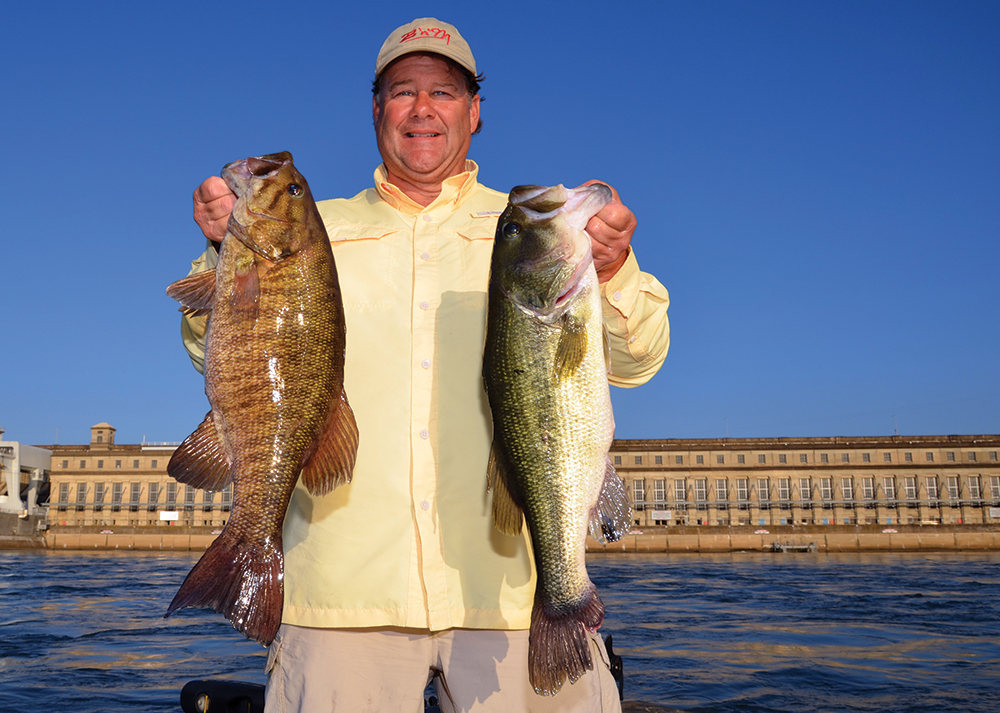Photos by John Felsher
From a hundred yards away, we could feel the awesome power of the churning white water rushing through two gates of Wilson Dam at Florence, Ala. Moments later, as the current steadily pushed the boat downstream, we each felt power of another sort as large fish inhaled our enticements.
“Current is essential to catching fish on Pickwick Lake,” says Brian Barton, a fishing guide from Muscle Shoals. “I firmly believe that the current coming out of the dam overrides any other factors such as the moon phases, barometric pressure or anything else. Anyone fishing when the dam is not generating current is not fishing at the prime time.”

Photos by John Felsher
On the downstream side of Wilson Dam, Pickwick Lake runs about 53 miles along the Tennessee River into Mississippi and Tennessee. While the reservoir can produce monster largemouth bass, Pickwick offers anglers outstanding lunker smallmouth bass action. The lake also produces big spotted bass and other species.
Smallmouth prefer more current and rocks than weed-loving largemouths. The best smallmouth fishing on Pickwick Lake usually occurs below Wilson Dam. Here, the river rushes through several channels pockmarked by numerous rocky shoals, islands, sandbars and other obstructions. When the dam gates open, current dislodges creatures from their hiding places and kicks off a bass feeding frenzy.
Many anglers exclusively fish for smallmouth and largemouth bass with artificial baits. But nothing looks better to a hungry bass than what it already wants to eat and expects to see. Before each trip, Barton throws his cast net to catch live shad.
“Fishing with live bait is a highly effective way to catch both big largemouth and smallmouth,” Barton says. “I prefer to fish with threadfin shad, but I’ll use whatever we can put in the baitwell. We can catch fish with this method all year long if we can find good bait, but the prime time for catching big bass on the Tennessee River with live bait is from October through March.”
With the current rolling, Barton hooks live shad onto the lines as we drift down the river. However, he wants to stay within a few hundred yards of the dam. When fishing with live shad, Barton generally uses no weight, but sometimes attaches a small split-shot sinker to the line to hold the bait near the bottom in swift current. Ideally, the bait should hover just off the bottom and move downstream at the same speed as the water flow.
“Most people think fishing with live bait is ‘idiot fishing,’ but there’s a little bit of art to it,” Barton says. “I match the weight to the current flow. I want the bait to flow along with the current just off the bottom. If I use too much weight, it will stay hung up. If I don’t use enough weight, the bait will float above the strike zone.”
For the best results, drift baits close to rock piles, sandbars, humps, fallen logs or other current breaks that might hold fish. Pickwick Lake even contains some ancient, now submerged, Indian mounds. Smallmouth and largemouth bass both tend to hide behind such obstructions and face upstream waiting to grab any temptations washed toward them.
When they see something they like, they dash out into the current to snatch those succulent morsels before returning to their lairs in the relatively slack water behind the structures. When the dam doesn’t generate current, Barton frequently anchors around shell mounds, rock piles, old jetties or other structures that might attract fish.
Where the ranges of northern and southern species overlap, Pickwick fishermen using live bait might catch a dozen or more different species on any given day. Almost every predator in the lake readily devours shad. Besides smallmouth, largemouth and spotted bass, anglers might also catch freshwater drum, flathead, blue or channel catfish, black or white crappie, white bass, hybrid bass, striped bass, possibly even a walleye, sauger, yellow perch or other species.
“One of the great things about fishing live bait on the Tennessee River is the variety of fish we might catch,” Barton says. “We’ve had many days where we’ve caught smallmouths and largemouths, plus seven to nine other species. When fishing live shad, we never know what might be biting on the other end of the line.”
Anglers could also use these methods to catch bass in any Tennessee River tailrace or other places with a little current. Check the Wilson Dam generation schedule at www.tva.gov/Environment/Lake-Levels/Wilson.
For area information, contact the Colbert County Tourism and Convention Bureau (colbertcountytourism.org) or Florence-Lauderdale Tourism at visitflorenceal.com.




